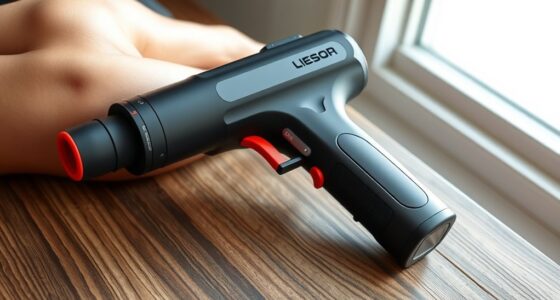If you’re a photographer using Lightroom in 2025, I recommend the latest MacBook Pro models with powerful M4 chips, like the M4 Max and M4 Pro. They offer top processing speeds, vibrant color accuracy, and excellent display quality to handle large files easily. Portability and long battery life are also key, along with versatile ports for connecting external drives. Keep watching, because I’ll share more details to help you pick the perfect fit.
Key Takeaways
- The latest M4 Pro and M4 Max MacBook Pros deliver exceptional processing power for smooth Lightroom editing and batch processing.
- High-resolution Liquid Retina XDR displays with true color accuracy ensure precise photo editing and vibrant visuals.
- Minimum 32GB RAM and fast NVMe SSD storage support large catalogs, multitasking, and quick workflow management.
- Versatile ports, including Thunderbolt 5 and SDXC card slot, facilitate seamless photo transfers and external device connections.
- Long-lasting batteries and portable designs make these models ideal for on-the-go photographers in 2025.
Apple 2024 MacBook Pro Laptop with M4 Pro
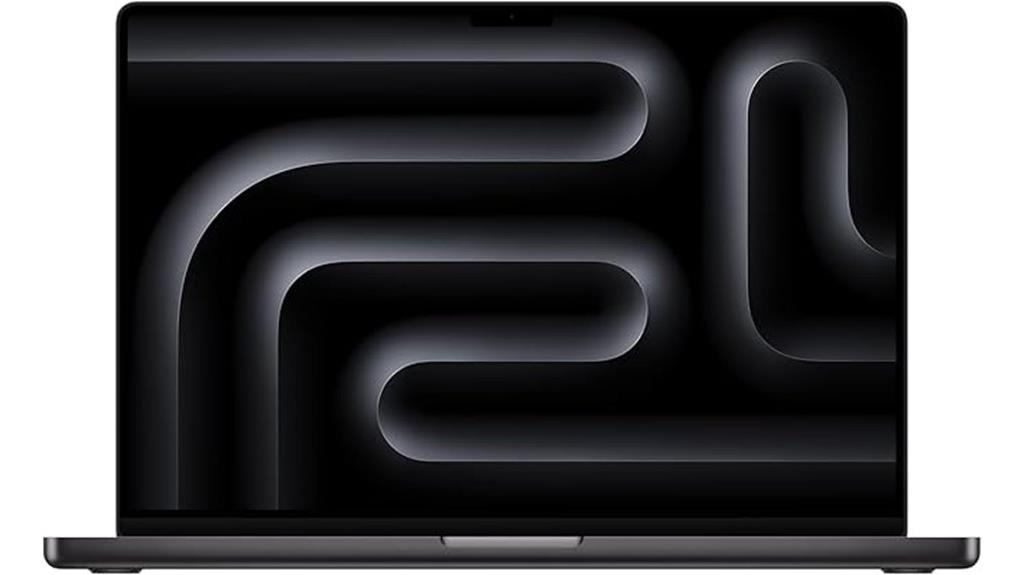
If you’re a photographer who needs powerful hardware to handle large files and complex editing, the 2024 MacBook Pro with M4 Pro is an ideal choice. Its M4 Pro chip delivers lightning-fast performance for demanding tasks like photo editing and batch processing. The 16.2-inch Liquid Retina XDR display offers vibrant visuals with exceptional contrast, perfect for detailed work. With up to 48GB of unified memory and a 512GB SSD, it ensures smooth multitasking and quick access to your files. Plus, its robust connectivity options, including Thunderbolt 5 ports and SDXC card slot, make it easy to transfer and manage your photos efficiently.
Best For: photographers and creative professionals who require powerful hardware, vibrant displays, and fast data transfer for editing large files and managing complex workflows.
Pros:
- High-performance M4 Pro chip handles demanding editing and processing tasks with ease
- Stunning 16.2-inch Liquid Retina XDR display offers vibrant visuals and exceptional contrast for detailed work
- Extensive connectivity options including Thunderbolt 5, SDXC card slot, and HDMI facilitate efficient photo transfer and management
Cons:
- Premium price point may be a barrier for some users
- Limited storage options starting at 512GB SSD might require external drives for extensive photo libraries
- The device’s size and weight could be less portable for users needing ultra-light laptops
Apple MacBook Pro 14-inch with M4 Max (2024)

Photographers seeking a powerful, portable device will find the MacBook Pro 14-inch with M4 Max (2024) to be an ideal choice. It packs a 14-core CPU, up to 40-core GPU, and a 16-core Neural Engine, making demanding tasks like photo editing, 3D rendering, and media processing seamless. Its stunning 14.2-inch Liquid Retina XDR display delivers vibrant colors, deep contrast, and support for multiple external displays. With up to 128GB of RAM and 8TB of storage, it handles huge files effortlessly. Plus, the impressive battery life, fast-charging, and versatile ports make it perfect for on-the-go professionals who need power and portability in one device.
Best For: Creative professionals, photographers, and on-the-go users who require powerful performance, stunning display quality, and versatile connectivity in a portable device.
Pros:
- Exceptional performance with up to 40-core GPU and 128GB RAM for demanding tasks
- Stunning 14.2-inch Liquid Retina XDR display with vibrant colors and deep contrast
- Long battery life of up to 18 hours and fast 96W charging for extended portability
Cons:
- Premium price point may be a barrier for some users
- Limited to Apple ecosystem, which may not suit all workflows
- Slightly heavier compared to some ultra-light laptops at 3.56 pounds
Apple 2024 MacBook Pro with M4 Max Chip, 16-inch, 36GB RAM, 1TB SSD, Silver (Renewed)
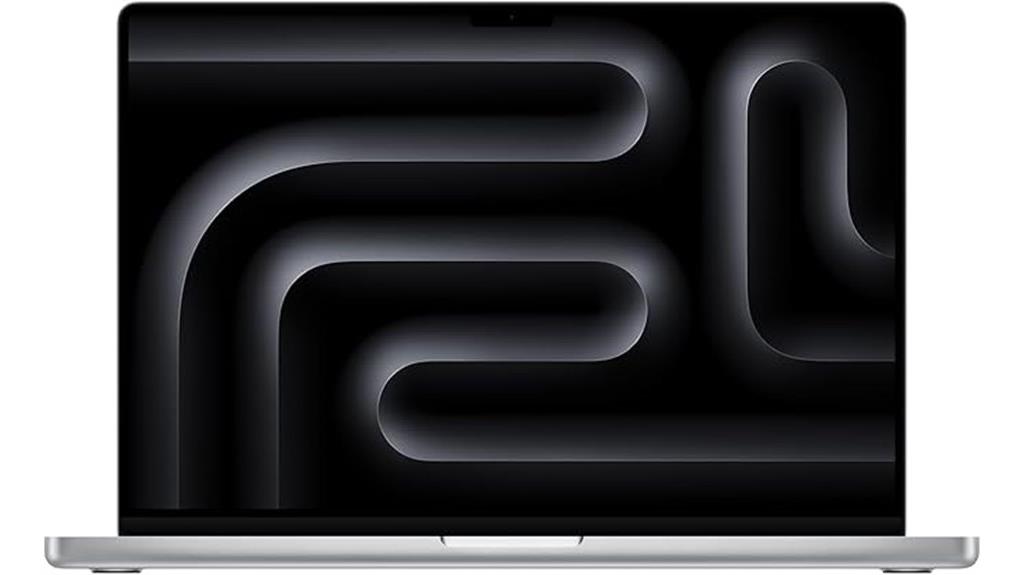
The Apple 2024 MacBook Pro with M4 Max chip is an exceptional choice for photographers who demand powerful performance and stunning visuals. Its 16-inch Liquid Retina XDR display offers vibrant images with up to 1600 nits brightness and a 3456×2234 resolution, perfect for editing detailed photos. The M4 Max chip, combined with 36GB of RAM and a 1TB SSD, handles demanding workflows like Lightroom, Photoshop, and video editing with ease. Weighing just under 5 pounds, it’s portable yet packed with connectivity options, including Thunderbolt 5, HDMI, and SDXC. This renewed model provides high-end specs at a reduced cost, making it a smart investment for professionals.
Best For: Professional photographers and creative experts seeking a powerful, portable MacBook Pro with stunning display quality and robust performance for editing and multimedia workflows.
Pros:
- Exceptional 16-inch Liquid Retina XDR display with vivid colors and high brightness for detailed photo editing
- Powerful M4 Max chip with 36GB RAM and 1TB SSD ensures smooth handling of demanding creative applications
- Versatile connectivity options including Thunderbolt 5, HDMI, and SDXC card slot for seamless external device integration
Cons:
- Slightly heavy at under 5 pounds, which may affect portability for some users
- Premium features come at a higher price point, even in renewed condition
- Limited to macOS, which might not suit users preferring Windows-based workflows
Apple MacBook Pro 2024 with M4 Chip (14.2-inch)

Looking for a laptop that can handle stunning photo edits with exceptional color accuracy and detail? The Apple MacBook Pro 2024 with M4 chip (14.2-inch) is an excellent choice. Its Liquid Retina XDR display offers 3024×1964 resolution, a billion colors, and ProMotion refresh up to 120Hz, making every image pop. Powered by the 10-core M4 chip, it delivers impressive speed and efficiency, perfect for Lightroom workflows. With up to 24 hours of battery life, multiple ports including Thunderbolt and HDMI, and advanced camera and audio features, this MacBook Pro combines portability with professional-grade performance for photographers.
Best For: creative professionals and photographers seeking a portable laptop with stunning display quality and powerful performance for editing high-resolution images.
Pros:
- Exceptional Liquid Retina XDR display with 1 billion colors and ProMotion up to 120Hz for accurate and smooth image viewing
- Powerful M4 chip with 10-core CPU and GPU, ideal for demanding photo editing workflows
- Long-lasting battery life up to 24 hours, supporting extended creative sessions
Cons:
- Limited to 512GB or 1TB SSD storage options, which may require external storage for large projects
- No AV1 hardware-accelerated decode support, potentially affecting playback of some newer video formats
- Slightly higher weight (3.41 pounds) compared to ultra-lightweight laptops, which may impact portability for some users
Apple 2024 MacBook Pro Laptop with M4 Max
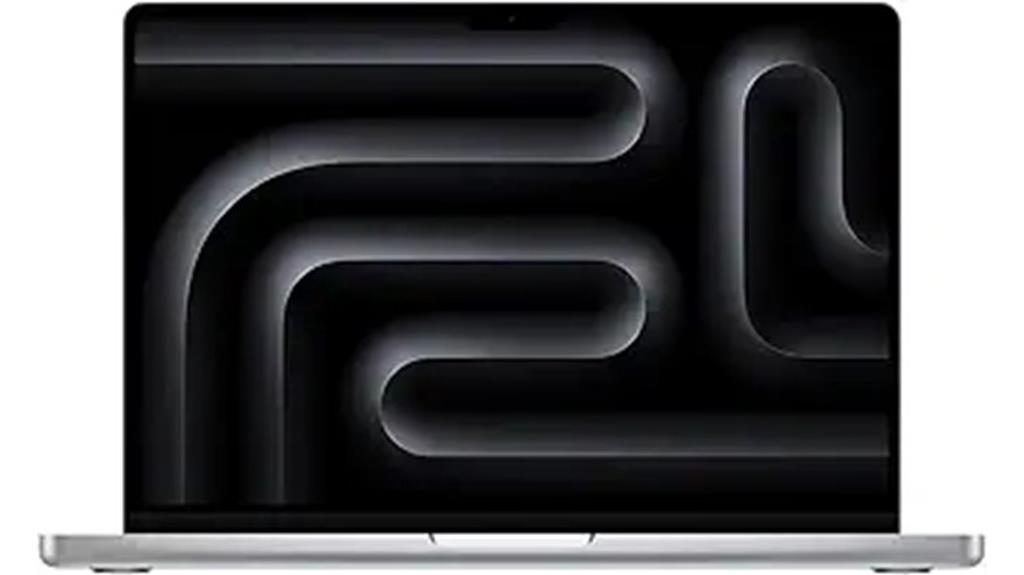
If you’re seeking a powerful laptop that can handle demanding creative workflows, the Apple 2024 MacBook Pro with M4 Max is an ideal choice. It’s equipped with either the M4 Pro or M4 Max chip, delivering exceptional performance for intensive tasks like rendering high-resolution images or complex 3D content. The 14.2-inch Liquid Retina XDR display offers stunning visuals with up to 1600 nits of brightness and a 1,000,000:1 contrast ratio, perfect for photo editing. With all-day battery life, seamless Apple ecosystem integration, and versatile ports—including SDXC and HDMI—it’s designed for creative professionals who need speed, clarity, and connectivity.
Best For: creative professionals and power users who require high-performance computing, stunning visuals, and versatile connectivity for demanding workflows.
Pros:
- Exceptional performance with M4 Max chip capable of handling complex 3D rendering and high-resolution editing
- Stunning 14.2-inch Liquid Retina XDR display with high brightness and contrast for vivid visuals
- Seamless integration within the Apple ecosystem enhances productivity and user experience
Cons:
- Premium price point may be prohibitive for some users
- Slightly heavier and larger than ultraportable laptops, affecting portability
- Limited to Apple-specific software and ecosystem, which may not suit all workflows
Factors to Consider When Choosing a Macbook Pro for Photographers and Lightroom
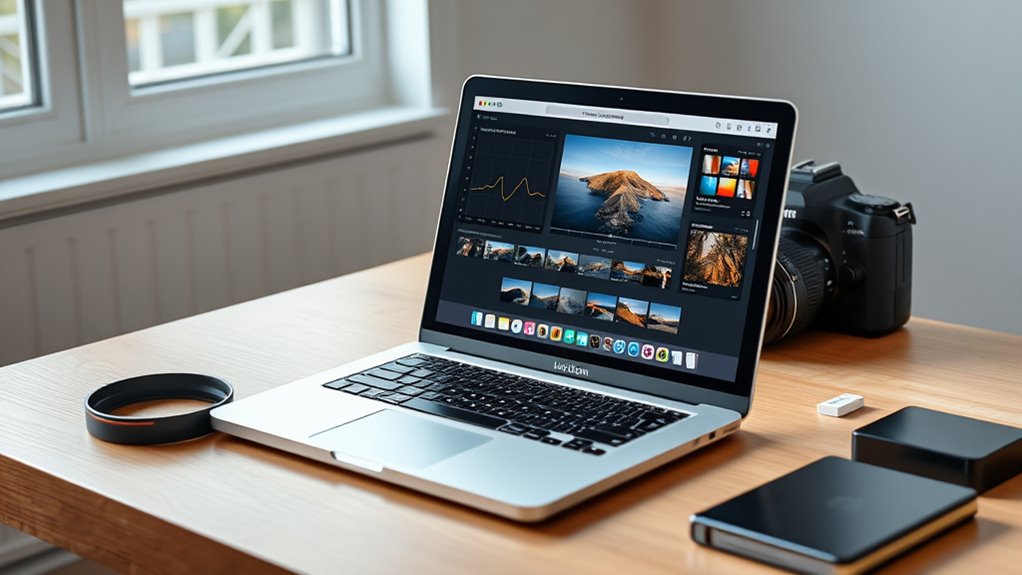
When choosing a MacBook Pro for photography and Lightroom, I focus on display quality, processing power, and storage options to guarantee smooth editing. Color accuracy and a wide gamut are essential for true-to-life images, while enough ports keep my workflow seamless. Considering these factors helps me pick a machine that matches my creative needs perfectly.
Display Quality and Brightness
A high-quality display is essential for photographers using a MacBook Pro, as it directly influences the accuracy of photo editing and the ability to see fine details. A resolution that’s sharp with true-to-life color reproduction, like the P3 wide color gamut, ensures colors are accurate and consistent across projects. Brightness levels of at least 1000 nits allow me to review images in various lighting conditions without losing detail in shadows or highlights. A contrast ratio of 1,000,000:1 helps distinguish subtle differences in dark and bright areas, making edits more precise. Support for HDR content and true tone technology further enhances my ability to assess images realistically. An adaptive refresh rate, such as ProMotion up to 120Hz, provides smooth viewing and editing experiences, reducing lag and eye strain.
Processor Power and Speed
Why does processor power matter so much for photographers using a MacBook Pro? Because it directly impacts how smoothly I can handle large RAW files and complex edits in Lightroom. A powerful chip, like the M4 Max with a 14-core CPU and 32-core GPU, reduces lag during filtering, batch processing, and exporting. Higher clock speeds and multiple cores mean quicker rendering of high-resolution images and video previews, saving me time. The fast neural engine accelerates AI-based features, making edits more efficient. Upgrading to the latest processor guarantees my MacBook Pro stays relevant as Lightroom and other software evolve, future-proofing my workflow. In short, a robust processor is essential for seamless, professional-level editing without frustration or delays.
Memory and Storage Options
Processor power helps speed up editing and rendering, but adequate memory and storage are just as important for maintaining smooth workflows. I recommend opting for at least 32GB of RAM to handle large Lightroom catalogs and multiple edits simultaneously without lag. Storage-wise, a minimum of 512GB SSD is essential to store high-resolution RAW files comfortably, but 1TB or more is ideal for extensive photo libraries. Faster storage options, like NVMe SSDs, considerably cut load and save times, saving you valuable editing minutes. Upgrading to larger capacities ensures you have enough space for ongoing projects, backups, and future collections, reducing the need for external drives. Overall, investing in ample memory and fast, spacious storage boosts efficiency and keeps your workflow seamless.
Color Accuracy and Gamut
Ever wonder how to guarantee your photos look true to life on your MacBook Pro? The key is a display that covers a wide P3 color gamut, ensuring vibrant, accurate colors essential for professional editing. High contrast ratios and HDR support let you review images with precise tonal differentiation, making subtle details pop. A display supporting 1 billion colors provides smooth gradations, perfect for fine-tuning images in Lightroom. Technologies like True Tone and ProMotion help maintain consistent color accuracy and deliver fluid visual performance during editing sessions. Additionally, peak brightness levels of up to 1600 nits allow you to see subtle details in HDR and color-sensitive images, ensuring your final edits are both accurate and vibrant across different viewing environments.
Port Selection and Connectivity
Choosing the right MacBook Pro for photography means paying close attention to its port selection and connectivity options, as these directly impact your workflow. You’ll want enough Thunderbolt 4 or 5 ports to connect multiple external devices like card readers, external drives, and monitors without hassle. An SDXC card slot is essential for quick transfer of high-res images straight from your camera, saving time. HDMI ports are useful for connecting to external displays or TVs for media review and color calibration, while a headphone jack allows for reliable audio monitoring during editing. Opt for a model with versatile ports to minimize the need for adapters or dongles, ensuring a smoother, more efficient editing process. Good connectivity keeps your creative flow uninterrupted and simplifies your workspace.
Battery Life and Portability
When selecting a MacBook Pro for photography and Lightroom editing, battery life and portability are crucial factors that can make or break your workflow. A longer battery life means I can edit and review images on the go without constantly searching for power outlets. Models with high-capacity batteries, like 72.4Wh or more, support extended sessions in demanding applications. Portability is equally important; lighter, more compact designs with smaller screens make it easier to carry my device between outdoor shoots and editing sessions. Reliable battery performance during intensive tasks ensures I won’t be interrupted during long workflows. Ultimately, a balance of long-lasting power and lightweight design allows me to work efficiently, whether I’m in the studio or out in the field.
Compatibility With Editing Software
Battery life and portability are essential for mobile editing, but guaranteeing your MacBook Pro is compatible with your editing software is equally important. I look for models with high-resolution displays like Liquid Retina XDR or ProMotion tech, which offer accurate color reproduction—crucial for editing photos precisely. Supporting wide color gamuts such as P3 and True Tone ensures vibrant images look authentic on screen. I also check for ample RAM (at least 16GB) and fast SSD storage to handle large Lightroom libraries smoothly. Compatibility with Adobe Creative Cloud, including Lightroom optimized for macOS and Apple Silicon, is a must. Additionally, strong GPU capabilities, whether dedicated or hardware-accelerated, improve rendering and editing workflows, making the whole process efficient and enjoyable.
Price and Upgrade Potential
Since your workflow depends heavily on handling large Lightroom catalogs and high-resolution images, it’s essential to select a MacBook Pro with sufficient RAM and storage from the start. Aim for at least 16GB of RAM, preferably 32GB or more, to guarantee smooth performance now and in the future. Storage capacity matters too; 1TB or more SSD storage helps you keep extensive photo libraries onboard without relying on external drives. Keep in mind that many newer MacBook Pros have non-upgradable internal components, so choosing higher specs upfront is critical. While internal memory can’t be upgraded later, you can expand storage externally. Pay attention to the processor—an M4 Pro or M4 Max will deliver the power needed for efficient editing and rendering over time. Investing in higher specs now boosts longevity and productivity.
Frequently Asked Questions
How Does the M4 Chip Improve Lightroom Performance?
The M4 chip boosts Lightroom performance considerably by providing faster processing speeds and improved graphics capabilities. I notice quicker rendering times, smoother editing, and seamless multitasking when working on large RAW files. Its advanced neural engine also accelerates AI features like noise reduction and sharpening, making my workflow more efficient. Overall, the M4 chip helps me edit more creatively without frustrating delays, especially with high-resolution images.
What Storage Options Are Best for Large Photo Libraries?
So, you want to store your vast photo library? I recommend going for at least 2TB of SSD storage—nothing kills creativity faster than running out of space. External drives are fine, but internal SSDs make editing smoother and faster. If you’re serious, opt for customizable storage options or consider cloud backups for peace of mind. After all, your masterpieces deserve the best home, right?
Is a Dedicated GPU Necessary for Editing in Lightroom?
A dedicated GPU isn’t strictly necessary for editing in Lightroom, but it definitely helps. I find that a good GPU accelerates rendering, previews, and smooths out performance during intensive edits. If you work with large files or multiple layers, a dedicated GPU makes a noticeable difference. However, for casual or hobbyist use, integrated graphics often suffice. Ultimately, it depends on your editing needs and budget.
How Does Battery Life Impact Long Editing Sessions?
Battery life really matters during long editing sessions because it determines how long I can work without constantly plugging in. When my battery lasts longer, I stay focused and less interrupted, especially when I’m on the go or working in locations without easy power access. A strong battery lets me finish projects smoothly and efficiently, making it a vital factor when choosing a MacBook Pro for photo editing.
Are There Specific Ports That Enhance Photo Workflow Efficiency?
Ports are like bridges connecting my workflow; they truly boost efficiency. I prefer Thunderbolt 4 and USB-C ports for fast data transfer, which feels like a quick heartbeat during editing. An SD card slot is a game-changer, letting me transfer photos without adapters, saving time and frustration. Multiple ports mean I can connect external drives, displays, and accessories seamlessly, keeping my creative process flowing smoothly without interruptions.
Conclusion
If you’re serious about editing photos in Lightroom, investing in a powerful MacBook Pro is a game-changer. The M4 Max models, with their impressive 36GB RAM and fast SSDs, guarantee smooth workflow even with large files. Did you know that high-end Macs can reduce rendering times by up to 50%? That’s a huge boost for productivity. Choosing the right model means faster edits and more time to focus on your creative vision.





